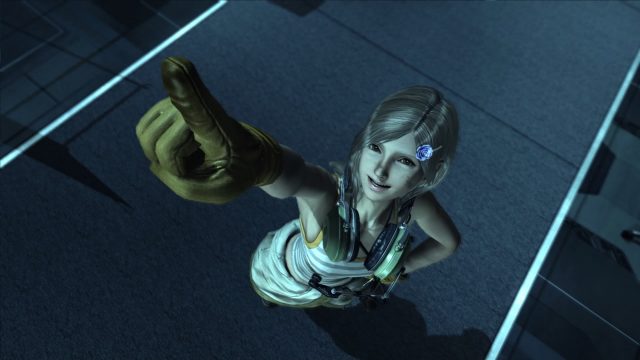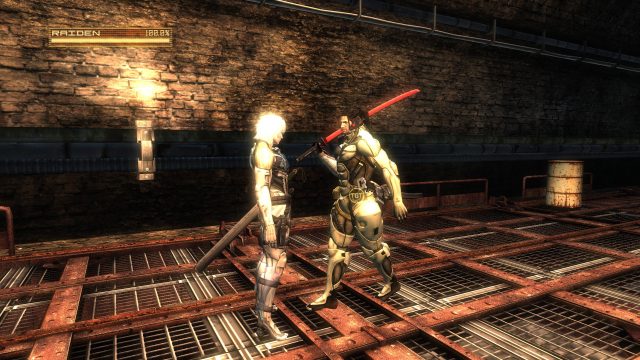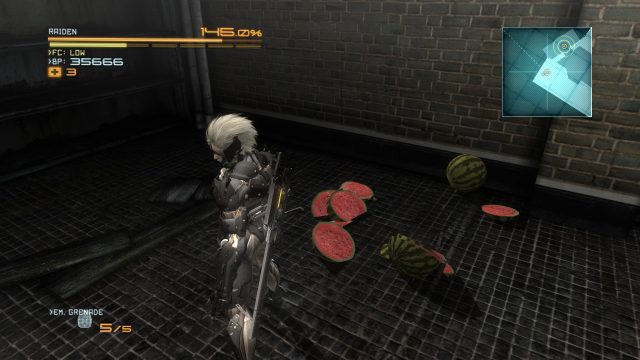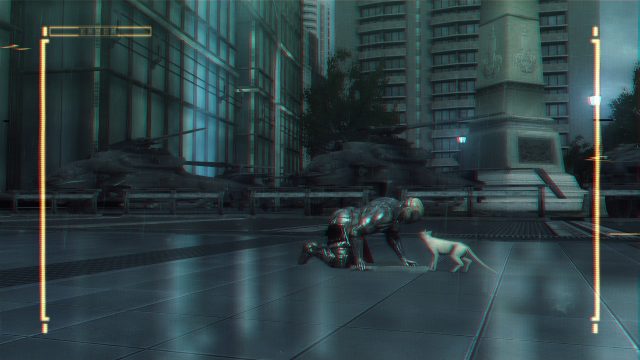Sometimes I feel like PlatinumGames can’t make a bad game. Something niche, sure. But that niche will worship this game forever and consider it one of the best of all time. This is the team that has an understanding of action in their blood and western developers can just scream “FUCK YOU!” with impotence. Finally, one of their titles is on PC and it feels my dark soul with liiiiiight (11!!!11). Metal Gear Rising: Revengeance… And I gotta say that Revengeance is a silly word but is actually real. And here I was hoping for a sequel called Unvengeance. I’m still hoping for a sequel, though. I mean, a PC port of Bayonetta would be great as well, but until that happens, we have MGR: Revengeance to fill that genre void on PC. And besides, the games are so wildly different despite their similarities.
So, how does MGR play? It’s an action adventure stealth hack n slash, mostly based on the genre defining elements from Devil May Cry. But MGR is more different from DMC than DMC was from Bayonetta. Bayo was more or less DMC, but faster and more agile. MGR changes a lot of rules and adds a lot of new concepts. For one, in MGR you mainly use one main weapon (which can be changed to a different one), which can have several additional ones to serve as “heavy hits”. And because of this, it’s less about variety of your combos, like it was in Bayo, even if that is still covered by stats. No, instead MGR is about precision, agility, speed and defense. And one of the biggest elements of the game plays into all of that – Zandatsu.
This invented Japanese word means “cut and take” and a lot of the game is designed around it. Raiden has a special mode in gameplay called “Blade Mode”. When you switch to it you go in the behind the shoulder view and can precisely aim your cuts. Cuts can be done with face buttons randomly (light attack is horizontal, heavy attack is vertical), or via the use of the right stick which is somewhat reminiscent of how the blade was used in MGS2. When Raiden has enough energy, or when countering or finishing an enemy, entering the mode slows down time and makes so that each cut either cuts the enemy or cuts off their armor. That or any other surface in the level that can be cut. When the enemy is ready to be cut like that, when they’re weakened or when they’re of a simpler variety, they also show a square when you look at them in Blade Mode. Cutting through that square nets a, well, battery spine, which refills Raiden’s health and energy, which is exactly what “cut and take” is.
It might sound easy, but in practice is a challenging but rewarding move to pull off. Enemies can still move in Blade Mode, and if you’re entering it not out of a counter they will try to dodge (often successfully). And besides, Raiden can still get hit, at least not when countering (dunno if you are invulnerable or not, but I never got hit out of a counter). And of course, the farther into the game, the more you get enemies that cannot be simply cut and need to be roughened up first. This way, Zandatsu becomes one of the key mechanics of the game. It’s not just the main way to refill health and energy, it’s also usually a more important element in ranking for each fight than combos, unlike the usual DMC logic.
Another key difference with MGR is that it’s not about dodging – it’s about blocking and countering. You can dodge in the game and you should get it (it’s an optional skill, but grab it as soon as you can), it still has dodge offset for combos. But it’s not about dodging the same way Bayonetta was. If in Bayo you’d dodge to go into witch time, in MGR you block at the correct time to counter and go into Zandatsu. Blocking works… well, it’s weird to me, but to people who play fighting games it might be second nature. Essentially, you must flick the direction stick and light attack at the enemy attacking you to block and do that at a specific time to block perfectly and perform a counter. If you’re being comboed, you must perform this block for each and every attack. What is especially nice is that you can miss a few blocks, but then still be able to block, so don’t give up if you’ve missed the opening of the enemy combo, you can still block the rest. Anyway, countering is super important as it essentially makes performing the Zandatsu possible far quicker than if you just hit enemies – early enemies get weak from a single counter, later might need more persuasion. So learn the timings of their attacks.
Having all of these mechanics, MGR builds an exciting game out of it. It’s pretty challenging, yet not infuriating as long as you’re not trying to be perfect on your first go. This is not DmC, where I managed to get S or SS rank on all missions first try. On the hardest difficulty of those available at the start. In MGR I managed to get a stable respectable B on my first go in all missions, including the DLC ones. And after that, I managed to get better. Oh and since we’re talking about difficulty – if you’re a fan of Metal Gear, but don’t really care about action – play this on easy automatic. You’ll enjoy the story and the spectacle of Raiden cutting enemies into pieces without a care in the world.
But if you want to get involved, you must care about the rankings. Which are not always well designed. Though, I need to mention that a lot of the issues, including these, can probably be explained by the difficult development of the game itself. Originally Metal Gear Solid: Rising was developed by Kojima Productions on their newly made Fox Engine. Zandatsu was there from the start (originally shown in the trailer as zan-datsu), blade mode as well, Raiden was wearing a new suit while some of the enemies and characters were also more or less the same. But that original trailer shown years ago was more or less a tech demo and a pre-rendered concept video. In reality, the team had no idea how to develop the game with the concepts they had so the project was frozen for a while. After some time it was decided to work with PlatinumGames, an already established action studio, who could invent some fun gameplay for the concepts presented. The game was renamed (re-vengeance is explained by this restart of development, so it was vengeance, not it was the re-vengeance), the story was updated to happen after MGS4, not between 2 and 4 and the project was give rather limited time and budget for development. It’s surprising how great the game is, given how much of the team was at the time busy with The Wonderful 101, yet it did lead to some unfortunate elements in the game.
The ranking, for example, feels off occasionally. For example, there are a few battles that can be skipped if you’re stealthy (which makes sense since this is Metal Gear and the game has a mechanic for stealth), yet if you skip them, you get lower overall ranking. This is somewhat fixed in the second story DLC to the game. Another problem lies in the fact that to get the max ranking you often need to get either best rank in every category, or most of that and at least one of two bonus categories. That is either taking no damage or killing no one. Killing no one only concerns fights with cyborgs, unmanned robots do not count, and can be rather complicated as you need to either use the special wooden sword to “knock them out”, or cut off their limbs and get far away so they “give up”. Taking no damage makes more sense, yet can be a problem since enemies have ranged weapons. You barely ever feel it, yet it does invalidate the no damage bonus and if you weren’t ninja running (which automatically deflects all bullets) when being shot at because of reasons, say goodbye to the no damage bonus.
Rocket wielding enemies are even more infuriating to deal with. Raiden cannot deflect those (he can cut them in Blade Mode though), yet the laser sight those enemies have is the same as for the rifle enemies. When they’re off-screen, you might have no clue what is aiming at you and get knocked down by the rocket, which is pretty annoying in the main game and is absolutely terrible in VR missions. Also they, obviously, can shoot rockets at point blank hurting themselves which can also be a problem. All those knockdowns, which can happen with the grab attacks as well, also require you to wiggle the stick. A lot. And it’s really annoying. There are fights, where Raiden can get into a more or less infinite cycle of being knocked down near a wall without being able to die quickly.
Camera doesn’t help. It seems like it’s reused from Bayo, but MGR levels are usually far more claustrophobic and have more visual clutter like furniture which makes the camera go completely nuts. And when some enemies, especially bosses, are too tall or somewhere high up, you get completely disoriented and confused. I’d recommend setting the camera sensitivity to the max setting before you even start playing and learn to move it during combat.
Camera also can make Zandatsu more challenging to pull off. It’s all fine in the early sections of the game, but by the end the game requires you to be very precise and hit through several squares at once. All of the final boss fights are about that and it makes them far more annoying than they would normally be. There are two ways to aim in Zandatsu, yet both falter in these cases for different reasons.
And the PC version has its own problems. The game only runs in 16:9 resolutions (letterboxing all others) and cannot go higher than 1920×1080. Occasionally instead of letterboxing the game might stretch and some people report not being able to select their resolution at all. The game is mostly well optimized, but can have issues, especially if you have a high setting for the pieces you can cut things into. Timings for attacks were off in the original release but they were seemingly patched by now, a patch that also fixed crashing due to internet connection. And the overall title rank for the game (like in other MG games) can glitch out – I once got the ranking of the previous playthrough not the one that I’ve finished at that time.
Yet, these aren’t deal breakers and the PC version is the best version to play the game. It runs at stable 60 FPS, which is extremely important for a game like this. And it has all DLCs of the console releases and some of the new features. You can watch all the CODEC calls from the main menu after finishing the game (and they’re really nice and there are more of them then there was in MGS4). There’s an ability to fight all bosses of the game after you complete it and allDLCs. And you can play all of the infuriating VR missions, but let’s not talk about the bad things ( ._.).
The DLCs in this game, both cosmetic and story ones, are really good. I didn’t play the additional VR missions, because the main ones were enough to make me cry, but the story DLCs were really good. Playing as Sam feels very different, far closer to Vergil from DMC3, but more challenging since all of the AI of the enemies is far more aggressive in this DLC. And playing as the “dog-shaped robot buddy” is the opposite of Sam — Sam cannot stealth, while Blade Wolf is not as efficient in open combat. It’s really good and the ranking, as mentioned, was redesigned to fit the stealth better. It’s just a shame that you cannot play the main game with these characters.
Oh and the music deserves a special mention. First of all, it’s constantly building up in a smart dynamic way, which works wonders in the boss fights. For example, when you start the fight, the music starts with the basic more minimalistic main theme, the more you damage the boss, the more elements of the music appear in the mix and when an especially big moment during the fight happens, the vocals kick in. Vocals, by the way, are incredibly inventive here. The song lyrics are done to fit the story and the character, so they’re essentially part of the characters themselves, telling about what the boss character stands for and hinting at their backstory. It sounds weird and silly, but is done in a really cool way. Oh and also MGR is yet another good example of what I meant when talking about DmC. If I would’ve heard this soundtrack outside of the game, I wouldn’t have cared about it – it’s not my kind of thing. Yet after playing the game, I started liking it. But that’s not the main takeaway here. The main thing is that even though it’s not something that I care about or like, it fits the gameplay perfectly and helps me play better, where in DmC the soundtrack wasn’t just “not my thing” but also constantly got in the way and rythm of the game.
Metal Gear Rising: Revengeance — is a wonderful gift to PC players. It’s a bit rough around the edges, I’d love to see a sequel that fixes those and maybe teaches the players to play the game better than this game. But it’s absolutely great. Sure, I would’ve probably preferred Bayonetta on PC over this one, but I was given MGR and all I can say is “Please sir, can I have some more?”.
P.S. If you really don’t feel like playing the game, or just want to see it in action first, give a look to this wonderful let’s play of the game (or the same let’s play but with no commentary over cutscenes).










